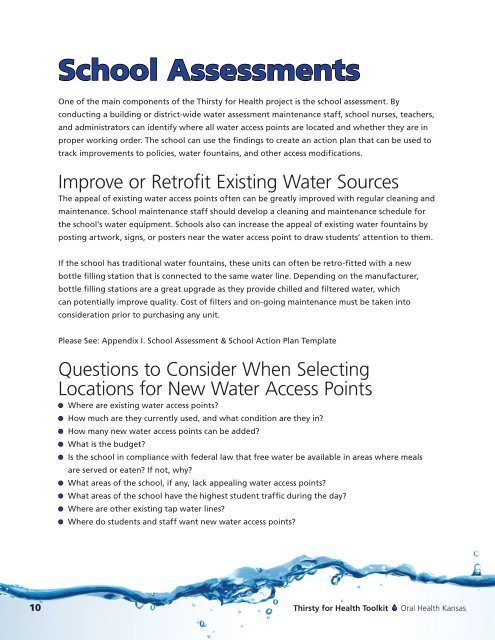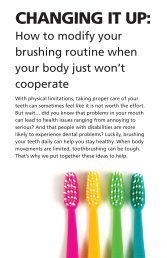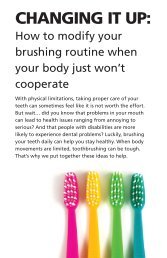Thirsty for Health Toolkit
Create successful ePaper yourself
Turn your PDF publications into a flip-book with our unique Google optimized e-Paper software.
School Assessments<br />
One of the main components of the <strong>Thirsty</strong> <strong>for</strong> <strong>Health</strong> project is the school assessment. By<br />
conducting a building or district-wide water assessment maintenance staff, school nurses, teachers,<br />
and administrators can identify where all water access points are located and whether they are in<br />
proper working order. The school can use the findings to create an action plan that can be used to<br />
track improvements to policies, water fountains, and other access modifications.<br />
Improve or Retrofit Existing Water Sources<br />
The appeal of existing water access points often can be greatly improved with regular cleaning and<br />
maintenance. School maintenance staff should develop a cleaning and maintenance schedule <strong>for</strong><br />
the school’s water equipment. Schools also can increase the appeal of existing water fountains by<br />
posting artwork, signs, or posters near the water access point to draw students’ attention to them.<br />
If the school has traditional water fountains, these units can often be retro-fitted with a new<br />
bottle filling station that is connected to the same water line. Depending on the manufacturer,<br />
bottle filling stations are a great upgrade as they provide chilled and filtered water, which<br />
can potentially improve quality. Cost of filters and on-going maintenance must be taken into<br />
consideration prior to purchasing any unit.<br />
Please See: Appendix I. School Assessment & School Action Plan Template<br />
Questions to Consider When Selecting<br />
Locations <strong>for</strong> New Water Access Points<br />
• Where are existing water access points?<br />
• How much are they currently used, and what condition are they in?<br />
• How many new water access points can be added?<br />
• What is the budget?<br />
• Is the school in compliance with federal law that free water be available in areas where meals<br />
are served or eaten? If not, why?<br />
• What areas of the school, if any, lack appealing water access points?<br />
• What areas of the school have the highest student traffic during the day?<br />
• Where are other existing tap water lines?<br />
• Where do students and staff want new water access points?<br />
10<br />
<strong>Thirsty</strong> <strong>for</strong> <strong>Health</strong> <strong>Toolkit</strong><br />
Oral <strong>Health</strong> Kansas








